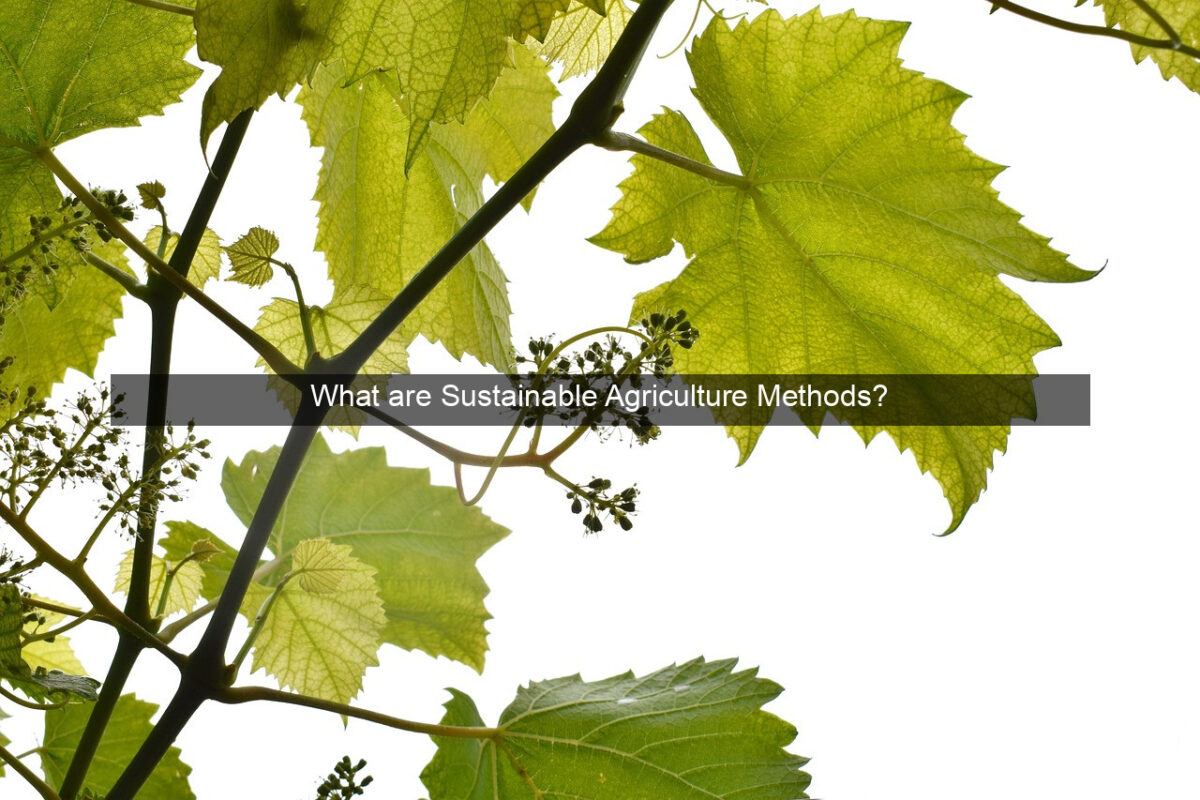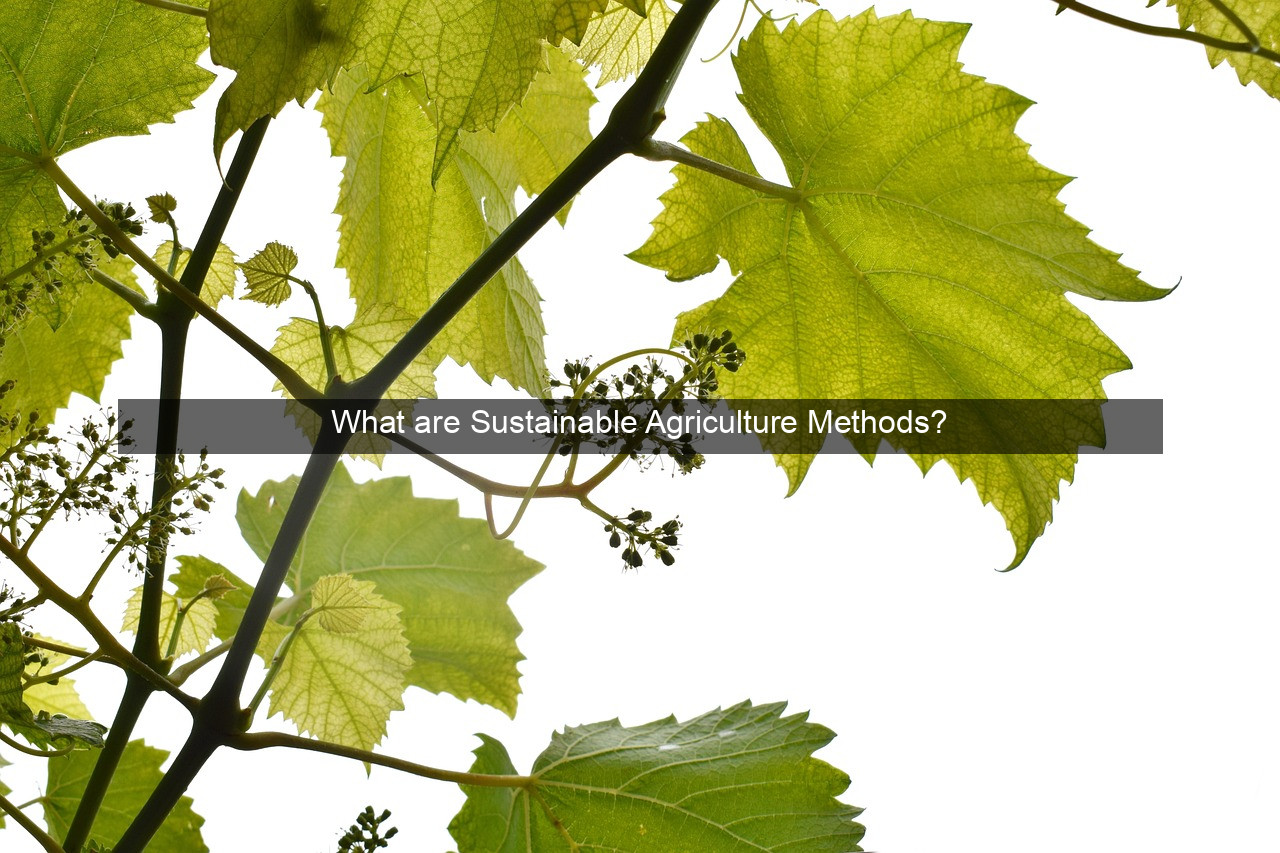What are Sustainable Agriculture Methods?

- What are Sustainable Agriculture Methods?
- What are Sustainable Agriculture Methods?
- Soil Health Management
- Cover Cropping
- No-Till Farming
- Composting and Manure Management
- Water Conservation
- Drip Irrigation
- Rainwater Harvesting
- Water-Efficient Crop Selection
- Integrated Pest Management
- Biological Control
- Crop Rotation
- Cultural Practices
- Benefits of Sustainable Agriculture
- Environmental Protection
- Economic Viability
- Social Equity
- Conclusion

What are Sustainable Agriculture Methods?
Our planet faces a growing challenge: feeding a burgeoning population while safeguarding our environment. Traditional agricultural practices, while effective in increasing yields, have often come at a cost to the health of our ecosystems. Soil degradation, water pollution, and biodiversity loss are just some of the consequences of unsustainable farming. Sustainable agriculture offers a path forward, a way to produce food that nourishes both people and the planet. It’s a holistic approach, encompassing a range of methods and techniques designed to minimize environmental impact while maximizing productivity and ensuring long-term agricultural viability. This approach moves beyond simply reducing harm and actively seeks to regenerate and enhance the natural systems upon which agriculture depends. From minimizing chemical inputs to promoting biodiversity, sustainable agriculture methods offer a diverse toolkit for building a more resilient and equitable food system.

Soil Health Management
Cover Cropping
Cover cropping involves planting crops like rye, clover, or vetch, not for harvest but to improve soil health. These crops protect and enrich the soil in various ways. They prevent erosion by holding the soil together, suppress weeds, and add organic matter back into the soil when they decompose. This improves soil structure, water retention, and nutrient availability.
Cover crops also play a vital role in nutrient cycling. They can capture excess nitrogen in the soil, preventing it from leaching into waterways and causing pollution. Leguminous cover crops, such as clover, can even fix atmospheric nitrogen, making it available for subsequent cash crops and reducing the need for synthetic fertilizers.
By improving soil health, cover cropping enhances the resilience of farming systems. Healthier soils are better equipped to withstand droughts, floods, and other extreme weather events, ensuring more stable and consistent yields over time.
No-Till Farming
No-till farming is a method that minimizes soil disturbance by avoiding plowing or tilling. This practice helps to preserve soil structure, reduce erosion, and improve water infiltration. Leaving crop residue on the soil surface also helps to suppress weeds and conserve moisture.
No-till systems often benefit from increased soil organic matter content over time. This is because the undisturbed soil allows organic matter to accumulate, leading to improved soil fertility and water-holding capacity. Healthier soils, in turn, support healthier crops and reduce the need for external inputs.
By reducing soil disturbance, no-till farming also minimizes the release of greenhouse gases from the soil. This contributes to mitigating climate change and promoting a more sustainable agricultural system.
Composting and Manure Management
Composting and manure management are crucial components of sustainable agriculture, providing a valuable source of organic matter and nutrients. Composting involves the controlled decomposition of organic materials, such as crop residues and animal manure, into a nutrient-rich soil amendment. Proper manure management ensures that nutrients are utilized effectively while minimizing environmental risks.
Applying compost and manure to agricultural lands improves soil structure, water retention, and nutrient availability. These practices also help to reduce the need for synthetic fertilizers, which can have negative environmental impacts. By recycling organic materials, composting and manure management contribute to a more circular and sustainable agricultural system.
Effective composting and manure management also play a role in reducing greenhouse gas emissions. By capturing methane, a potent greenhouse gas, during the composting process, these practices contribute to mitigating climate change.
Water Conservation
Drip Irrigation
Drip irrigation delivers water directly to the plant roots, minimizing water waste and improving efficiency. This targeted approach reduces evaporation and runoff, making it a more sustainable alternative to traditional irrigation methods like flood or sprinkler irrigation.
By providing water directly to the root zone, drip irrigation also promotes healthier plant growth and reduces the risk of diseases associated with wet foliage. This can lead to increased yields and improved crop quality.
Drip irrigation systems can be adapted to various terrains and crop types, making them a versatile tool for water conservation in agriculture.
Rainwater Harvesting
Rainwater harvesting involves collecting and storing rainwater for later use in irrigation. This practice reduces reliance on groundwater and surface water sources, which can be stressed by agricultural demands.
Rainwater is a high-quality source of irrigation water, free from salts and other contaminants that can be present in groundwater or surface water. This can lead to improved crop health and yields.
Rainwater harvesting systems can range from simple rain barrels to more complex systems involving storage tanks and distribution networks.
Water-Efficient Crop Selection
Choosing crops that are well-suited to the local climate and require less water is a crucial aspect of sustainable agriculture. This reduces the overall demand for irrigation and helps to conserve water resources.
Drought-tolerant crops are particularly valuable in arid and semi-arid regions, where water scarcity is a major challenge. These crops can thrive with less irrigation, contributing to more sustainable agricultural practices.
Selecting water-efficient crops also reduces the strain on water resources, allowing for more equitable distribution of water for other uses.
Integrated Pest Management
Biological Control
Biological control involves using natural enemies of pests, such as predators, parasites, or pathogens, to control pest populations. This approach reduces the need for synthetic pesticides, which can have negative impacts on human health and the environment.
Introducing beneficial insects, like ladybugs or lacewings, can help to control aphid populations. Similarly, certain bacteria or fungi can be used to target specific pests.
By harnessing natural processes, biological control promotes a more balanced and sustainable ecosystem.
Crop Rotation
Crop rotation involves planting different crops in sequence on the same piece of land. This practice helps to disrupt pest life cycles, reducing pest pressure and the need for pesticides.
Rotating crops can also improve soil health by diversifying the nutrients added to the soil and reducing the buildup of specific pests and diseases.
Crop rotation is a simple yet effective strategy for promoting sustainable pest management and improving overall farm resilience.
Cultural Practices
Cultural practices refer to various farming techniques that can help to prevent or manage pests. These practices can include adjusting planting times to avoid pest outbreaks, using resistant varieties, and maintaining good sanitation practices.
Properly timed planting can help to avoid periods when pest populations are at their peak. Using resistant varieties can reduce the susceptibility of crops to certain pests.
By implementing these cultural practices, farmers can minimize pest problems and reduce the need for chemical interventions.
Benefits of Sustainable Agriculture
Environmental Protection
Sustainable agriculture plays a crucial role in protecting the environment. By reducing chemical inputs, conserving water, and promoting soil health, it minimizes pollution and safeguards natural resources.
Reducing pesticide use protects pollinators and other beneficial insects, while conserving water helps to maintain healthy aquatic ecosystems.
Sustainable practices contribute to a healthier planet for both present and future generations.
Economic Viability
Sustainable farming practices can also enhance the economic viability of farms. By reducing input costs, improving yields, and increasing market access for sustainably produced food, farmers can improve their profitability.
Reduced reliance on expensive inputs like synthetic fertilizers and pesticides can lower operating costs. Improved soil health can lead to higher and more consistent yields.
Sustainable agriculture offers a pathway to long-term economic stability for farmers.
Social Equity
Sustainable agriculture can contribute to greater social equity by supporting small-scale farmers, promoting fair labor practices, and enhancing food security in vulnerable communities.
By providing access to sustainable farming techniques and resources, small-scale farmers can improve their livelihoods and contribute to local food systems.
Sustainable agriculture can play a vital role in building a more just and equitable food system.
| Method | Description | Benefit |
|---|---|---|
| Cover Cropping | Planting crops to improve soil health | Reduces erosion, improves soil fertility |
| No-Till Farming | Minimizes soil disturbance | Conserves soil moisture, reduces erosion |
| Drip Irrigation | Delivers water directly to plant roots | Conserves water, improves efficiency |
- Reduced reliance on synthetic fertilizers and pesticides
- Improved soil health and water quality
- Enhanced biodiversity and ecosystem services
Conclusion
Sustainable agriculture offers a vital pathway toward a more resilient and equitable food system. By embracing practices that prioritize environmental stewardship, economic viability, and social equity, we can build a future where agriculture nourishes both people and the planet. The transition to sustainable agriculture requires a collective effort, involving farmers, policymakers, researchers




